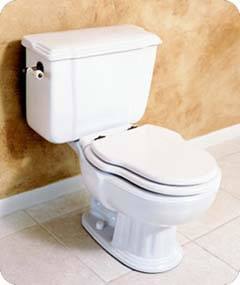McKinney Toilet Repair & Installation
972-552-7212A toilet is a fairly efficient appliance. Just push the lever and almost magically, in a few seconds, the toilet dispatches its contents with just a gurgle. Most toilets can get this job done with 2-3 gallons of water; newer models use only 1.5 gallons.

- Bathrooms
- Bathtubs
- Dishwashers
- Disposals
- Drain Snaking
- Faucets
- Flooding
- Drain Cleaning
- Tankless Systems
- Toilets
- Valves
- Ventilation
- Water Pressure
- Water Treatment
- Clogged Drains
- Plumbing Installs
- Dripping Faucets
- Filtration
- Kitchens
- Overflows
- Pipe Leaks
- Plumbing Fixtures
- Plumbing Repairs
- Rooter Service
- Running Toilets
- Showers & Sinks
- Slab Leaks
- Water Heaters
A leaking toilet, however, can waste hundreds or gallons of water a week. If each flush does not end with a gurgle, but instead continues with a hissing sound, with water running into the toilet bowl, you have a run-on toilet and this is a plumbing problem that needs to be fixed. The mechanism inside the toilet bowl may seem complicated, but it really isn't. Of course, as they do with almost every plumbing fixture, someone is always coming up with a better design. So, they all accomplish the same tasks. Here is a what happens in a typical McKinney toilet when you push the flush lever.
- The flush handle lifts a round rubber tank ball (or a rubber flapper) that is located in the base of the toilet tank. When the tank ball or flapper lifts, it opens the water passage between the tank and toilet bowl. As soon as this device lifts, water drains into the toilet.
- As the tank empties, the large ball, called a float ball, attached to the end of a long rod, falls with the water level in the tank. Some designs have a float ball that surrounds the intake valve.
- At the other end of the float ball rod is the float valve, which opens as the float ball moves down. Water begins to flow into the tank as the float valve opens.
- When the tank is almost empty, the tank ball or flapper falls into the outlet, stopping the flow of water out of the tank.
- When the drain is closed, the tank begins to fill. The float valve also directs some water into an overflow tube that drains into the toilet bowl to assure that the bowl fill with water.
- As the tank fills, the float ball rises with the water level until it gets to a predetermined position and closes the float valve, stopping the inflow of water.
The toilet is now ready for another flush and as long as nothing is leaking, no more water is used until the flush lever is pushed. A run-on toilet is usually caused by a problem with the tank ball, the float valve or intake valve, or the float ball.
Our McKinney plumbers repair and service all brands and models of toilet systems. If your McKinney toilet doesn't flush properly, the toilet bowl is leaking or you have any other problems, simply call us and we will take care of rest, returning your toilet to perfect working order. Call us 24/7 to schedule an appointment for your McKinney toilet repair. We work with your busy schedule to set up your McKinney toilet repair appointment. 972-552-7212.
McKinney Plumber Toilet Information – Did You Know...
Running Toilets
A leaking toilet could waste more than 133,000 gallons of water in one year! Leaking toilets are the most common cause of high water bills.
Toilet Floats & Fill Valves
Many new toilets don't have a float. The valve itself is sensitive to water pressure. When the tank is empty and there is no water pressure (after a flush) it opens to send new water into the tank. When the tank is full and the water pressure is high, it closes. Fewer moving parts could yield fewer future repairs.
Toilet Bowl Stains
You don’t need to live with toilet bowl stains. Most toilet bowls can be restored unless they are severely scratched or cracked. The inside surface of a toilet bowl is extremely hard, smooth and resistant to most chemicals. Toilets are formed from a ceramic clay similar to wall or floor tile, and are specially glazed to have a glass-like or “vitreous” surface. This silky-smoothness inhibits the growth of germs by making it difficult for waste to stick to the surface after flushing. Over time, constant exposure to water-borne minerals and chemicals can cause discoloration and staining, even on vitreous china, requiring more-than-superficial cleaning. Effective heavy-duty cleaning products fall into two general categories, acid-based or chlorine-based. Acid-based cleaners are most effective on mineral stains. Follow the instructions provided by the toilet and cleanser manufacturers for safe stain removal.
High Efficiency Toilets
Dual–flush toilets provide two flushing options. Solids are flushed with 1.6 gallons of water. Liquids are flushed by about half that volume ranging from 0.8 to 0.9 gpf. Most manufacturers offer at least one dual–flush toilet. The other option is a toilet equipped with pressure–assist technology, available from all leading manufacturers. Most common in hotels, restrooms and commercial buildings, these toilets also can be installed in homes. The pressure–assist system consists of a plastic pressure tank mounted inside the toilet tank. It uses pressure from the water supply line to compress air inside the pressure tank. This system traps and compresses air as it fills with water. The compressed air forces the water into the bowl when the toilet is flushed. The pressure–assist unit uses this force to push waste out, creating a vigorous flushing action that whisks away waste and cleans the bowl with only one gallon of water per flush. Call McKinney Plumbing Pro for advice on these toilet options.
More Info? See our McKinney Plumber Blog.
New: Kitchen Faucet Guide

